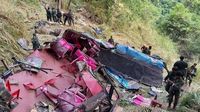On the night of September 4, 2025, a devastating bus accident unfolded in the mountainous heart of Sri Lanka, leaving a nation once again grappling with the dangers of its winding roads. Near the town of Wellawaya, about 280 kilometers east of Colombo, a packed passenger bus veered off a steep road and plunged nearly 1,000 feet down a precipice, killing 15 people and injuring at least 16 others, including five children. The tragedy has cast a harsh spotlight on the persistent risks facing travelers in the island nation’s hilly interior.
According to police spokesman Fredrick Wootler, as reported by the Associated Press, the accident occurred late Thursday as the bus, carrying nearly 30 people, lost control on a mountain road. "An initial police investigation revealed that the driver was driving the bus at high speed and lost control of it, crashing with another vehicle and into guardrails before toppling off the cliff," Wootler said. The force of the impact sent the vehicle careening off the edge, coming to rest at the bottom of the precipice in a tangle of metal, glass, and uprooted shrubs.
Local television footage, cited by Sky News, showed the mangled remains of the bus lying at the bottom of the slope. Rescue crews—soldiers, police officers, and volunteers—worked through the night in the harsh, unforgiving terrain to extract the injured and recover the bodies. The operation was grueling, with responders navigating steep, slippery ground under the cover of darkness.
The bus was carrying employees of the Tangalle Municipal Council, who had been returning from an excursion in Ella, a popular tourist destination known for its lush tea plantations and panoramic views. According to Caliber.Az, the group was headed back to the southern town of Tangalle when disaster struck near the 24th kilometer post on the Ella–Wellawaya main road. The victims included nine women, all of whom were employees of the council, as confirmed by The Indian Express. Among the injured were men, women, and children, several of whom were reported to be in critical condition after being admitted to Badulla Teaching Hospital.
Eyewitness accounts and survivor stories have begun to emerge, painting a harrowing picture of the moments leading up to the crash. One survivor, speaking with The US Sun, recounted how the bus driver managed to warn passengers just before the plunge. "The conductor shouted as loud as he could urging everyone to get low and hold on tight," the survivor said. In the chaos that followed, the bus struck the safety barriers twice with a loud bang before tumbling down the precipice. "I was thrown out of the bus through a broken window," the woman recalled, describing a scene of terror and confusion.
Authorities believe the tragedy was set in motion when the bus collided with an oncoming jeep, a detail confirmed by both The Indian Express and Sky News. The collision appears to have caused the bus to lose control, after which it smashed through the guardrails. There are indications that the bus’s brake system may have failed following the initial impact, further contributing to the driver’s inability to regain control.
As the investigation continues, the broader context of road safety in Sri Lanka is once again under scrutiny. Deadly bus accidents are, unfortunately, a recurring nightmare in the country—particularly in its mountainous regions. According to multiple outlets, including Sky News and the Associated Press, these incidents are often blamed on a combination of reckless driving, poorly maintained and narrow roads, and aging vehicles. The latest crash is the deadliest since May 2025, when 23 passengers lost their lives in a separate bus accident in Kotmale.
Photos from the scene—published by The US Sun and The Indian Express—show the bus overturned at the bottom of the mountainside, its roof partially ripped off and its seats and shattered glass strewn across the grass. Soldiers and police could be seen inspecting the wreckage, their faces grim as they pieced together the sequence of events. The bus, which had been carrying local tourists eager to experience the region’s famous tea plantation hill towns, now stood as a stark reminder of the dangers lurking on Sri Lanka’s scenic, but treacherous, roads.
Hospital officials at Badulla Teaching Hospital told Caliber.Az and Adaderana that more than 15 patients had been admitted, with several in critical condition. The community has rallied to support the victims and their families, but the sense of loss is palpable. The dead included nine women, all employees of the Tangalle Urban Council, whose absence will be deeply felt in their hometown.
In the aftermath, authorities have launched a full investigation into the cause of the accident. Police are examining the bus’s mechanical systems, the condition of the road, and the actions of both drivers involved in the initial collision. While the investigation is ongoing, early findings point to a tragic convergence of speed, mechanical failure, and the inherent risks of mountain travel.
For many in Sri Lanka, the crash has reignited calls for improved road safety measures. Advocates argue that stricter enforcement of speed limits, regular vehicle inspections, and better maintenance of mountain roads are urgently needed to prevent future tragedies. Yet, as history has shown, change comes slowly—often in the wake of terrible loss.
The Ella–Wellawaya main road, where the accident occurred, is notorious for its sharp bends and steep drops. It is a vital artery for both locals and tourists, connecting some of the country’s most picturesque destinations. But for those who travel it regularly, the beauty of the landscape is tempered by the knowledge that danger is never far away.
As Sri Lanka mourns the victims of this latest disaster, the hope is that the lessons learned will not be forgotten. The memories of those lost—mothers, fathers, children, and friends—now serve as a somber reminder of the urgent need for safer roads and more vigilant driving practices across the country. For the survivors and the families of the deceased, the road to healing will be long and difficult, but their stories may yet inspire meaningful change.
In the quiet aftermath, as the wreckage is cleared and the investigation proceeds, the hills of Wellawaya stand witness to another chapter in Sri Lanka’s ongoing struggle with road safety. The tragedy of September 4 will not soon be forgotten, etched into the collective memory of a nation determined to prevent such heartbreak in the future.






